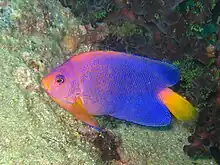Japanese angelfish
The Japanese angelfish (Centropyge interrupta) or Japanese pygmy angelfish, is a species of marine ray-finned fish, a marine angelfish belonging to the family Pomacanthidae. It is found in the western Pacific Ocean.
| Japanese angelfish | |
|---|---|
 | |
| Scientific classification | |
| Domain: | Eukaryota |
| Kingdom: | Animalia |
| Phylum: | Chordata |
| Class: | Actinopterygii |
| Order: | Perciformes |
| Family: | Pomacanthidae |
| Genus: | Centropyge |
| Species: | C. interrupta |
| Binomial name | |
| Centropyge interrupta (Tanaka, 1918) | |
| Synonyms[2] | |
| |
Description
The Japanese angelfish has an orange body marked with purple and blue spots It has an orangey yellow body with purplish blue spots completed with a bright yellow tail. The spots are larger towards the tail, and the bottom part the rear of the fish gradually becomes purple. The spots also turn from blue to purple towards the tail. Juveniles has a blue margined black ocellus on the posterior part of the dorsal fin.[3] The dorsal fin contains 14 spines and 16 soft rays while the anal fin has 3 spines and 17 soft rays. This species attains a maximum total length of 15 centimetres (5.9 in).[2]
Distribution
The Japanese angelfish is found in the western Pacific Ocean. They occur in southern Japan from Tokyo to Shikoku, as well as around the Izu Islands and the Ogasawara Islands south of Japan. They also occur in United States waters around Midway Atoll and Kure Atoll and reaching south to Pearl and Hermes Atoll.[1]
Habitat and biology
The Japanese angelfish is found at depths between 15 and 60 metres (49 and 197 ft).[1] They are typically encountered as pairs on rocky reefs where there are rich growths of coral and algae. Their diet consists of algae, benthic invertebrates and sponges.[4] They are oviparous and monogamous. Females change sex to males at a total length of 12.7 centimetres (5.0 in) and this takes 20–39 days to complete.[2]
Systematics
The Japanese angelfish was first formally described in 1918 by the Japanese ichthyologist Shigeho Tanaka (1878-1974) with the type locality given as Tanabe in the Wakayama Prefecture of Japan.[5] The specific name means “interrupted” and was not explained but may refer to the broken dusky bars on the head. Within the genus Centropyge this species is considered, by some authorities, to be in the subgenus Centropyge.[6]
Utilisation
The Japanese angelfish is not common in the aquarium trade although it does well a in captivity and has been successfully bred and reared in captivity.[1] They can command high prices within the trade.[7]
References
- Pyle, R.; Myers, R. & Craig, M.T. (2010). "Centropyge interruptus". IUCN Red List of Threatened Species. 2010: e.T165858A6150368. doi:10.2305/IUCN.UK.2010-4.RLTS.T165858A6150368.en. Retrieved 26 January 2021.
- Froese, Rainer; Pauly, Daniel (eds.) (2019). "Centropyge iterrupta" in FishBase. December 2019 version.
- "CENTROPYGE INTERRUPTA". De Jong Marine Life. Retrieved 26 January 2021.
- "Japanese Pygmy Angelfish (Centropyge interrupta)". What’s That Fish. Retrieved 26 January 2021.
- Eschmeyer, William N.; Fricke, Ron & van der Laan, Richard (eds.). "Species in the genus Centropyge". Catalog of Fishes. California Academy of Sciences. Retrieved 26 January 2021.
- Christopher Scharpf & Kenneth J. Lazara (21 July 2020). "Order ACANTHURIFORMES (part 1): Families LOBOTIDAE, POMACANTHIDAE, DREPANEIDAE and CHAETODONTIDAE". The ETYFish Project Fish Name Etymology Database. Christopher Scharpf and Kenneth J. Lazara. Retrieved 26 January 2021.
- "Saltwater Fish You Dream About Owning (16 Most Expensive Saltwater Fish)". News9.com. 29 August 2019. Retrieved 26 January 2021.
- "Centropyge interruptus". Integrated Taxonomic Information System. Retrieved 6 June 2006.
- Froese, Rainer; Pauly, Daniel (eds.) (2006). "Centropyge interrupta" in FishBase. May 2006 version.
